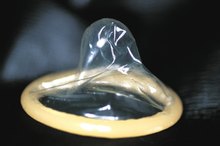How Much Semen Is a Body Able to Make?
Semen is the fluid produced by male animals to carry sperm to the female ovum for fertilization. It contains components to provide nutrients to the sperm, keep them viable in the female reproductive tract and dilute the sperm to facilitate transfer to the female. The volume of semen produced varies among individuals and among species, and can be influenced by several factors.
Tips
On average, a human male can produce between 2 and 5 milliliters of semen.
Semen Components
In humans, the volume of semen is only 2 to 5 percent sperm. The rest of the volume is made up of fluids secreted by the epididymus, prostate gland and seminal vesicles. The epididymus contributes a small volume of fluid containing the electrolytes potassium and sodium and some nutrients for the sperm. The prostate gland contributes about 30 percent of the seminal fluid, with secretions including citric acid, minerals and enzymes. The seminal vesicles contribute about 60 percent of the seminal fluid, with secretions including sugar, amino acids, citric acid and prostaglandin hormones. The bulbourethral gland secretes a small amount of mucus for lubrication.
- In humans, the volume of semen is only 2 to 5 percent sperm.
- The prostate gland contributes about 30 percent of the seminal fluid, with secretions including citric acid, minerals and enzymes.
Human Semen Production
What Causes Ejaculation?
Learn More
The average volume of semen produced at one time varies widely among individuals. The average human male produces a volume between 2 and 5 milliliters (0.06 to 0.17 U.S. fluid ounces). Semen volumes that are regularly lower than 1.5 milliliters (0.05 U.S. fluid ounces) are known as hypospermia, while semen volumes regularly higher than 5.5 milliliters (0.18 U.S. fluid ounces) are known as hyperspermia. Since semen is primarily made up of fluid secretions, the possible supply is inexhaustible.
- The average volume of semen produced at one time varies widely among individuals.
- Since semen is primarily made up of fluid secretions, the possible supply is inexhaustible.
Semen Volume in Other Species
Semen volume and semen concentration vary among species 2. To some extent, semen volume varies with body size. A mouse produces an average of 0.0015 milliliters (less than 0.01 teaspoon) at once, while the blue whale produces an estimated volume of 16,561 milliliters (17.5 quarts) of semen. Other animals produce more or less semen than would be expected for their body size. For example, pigs produce 200 milliliters (6.76 U.S. fluid ounces) of semen at once while the much larger bovine bull produces only 8 milliliters (0.27 U.S. fluid ounces) of semen, only slightly more than a man.
Factors That Influence Semen Volume
The Average Weight & Height for a 13-Year-Old
Learn More
Across species, evolutionary history influences how much semen is produced. Monogamous animals have different fertilization needs than species where a female may mate with more than one male. In the second case, males need a way to give their genetic material an advantage, which may include increasing semen volume, a phenomena known as sperm competition. At the individual level, semen volume generally increases from young to mature males in livestock species. To some extent, semen volume is heritable, or encoded by genetics. Genetic defects such as cryptorchidism, or undescended testicle, also influence semen volume.
- Across species, evolutionary history influences how much semen is produced.
- To some extent, semen volume is heritable, or encoded by genetics.
Related Articles
References
- Encyclopedia Britannica: Semen
- Net Doctor: Semen and Sperm Quality
- University of Wisconsin: Epididymis, Ejaculation, Semen
- Centers for Disease Control and Prevention. (May 2016). Gonorrhea - CDC Fact Sheet.
- Barrett T, Tanner J, Gill AB, Slough RA, Wason J, Gallagher FA. The longitudinal effect of ejaculation on seminal vesicle fluid volume and whole-prostate ADC as measured on prostate MRI. Eur Radiol. 2017;27(12):5236-5243. doi:10.1007/s00330-017-4905-x
- Stocks CJ, Phan MD, Achard MES, et al. Uropathogenic employs both evasion and resistance to subvert innate immune-mediated zinc toxicity for dissemination. Proc Natl Acad Sci USA. 2019;116(13):6341-6350. doi:10.1073/pnas.1820870116
- McKay AC, Sharma S. Anatomy, Abdomen and Pelvis, Seminal Vesicle. Treasure Island, FL: StatPearls Publishing; 2019.
- Owen DH, Katz DF. A review of the physical and chemical properties of human semen and the formulation of a semen simulant. J Androl. 2005;26(4):459-69. doi:10.2164/jandrol.04104
- Mathers MJ, Degener S, Sperling H, Roth S. Hematospermia-a Symptom With Many Possible Causes. Dtsch Arztebl Int. 2017;114(11):186-191. doi:10.3238/arztebl.2017.0186
- Centers for Disease Control and Prevention. STD Facts - Gonorrhea. Updated January 29, 2014.
- Centers for Disease Control and Prevention. (May 2016). Gonorrhea - CDC Fact Sheet.
- Owen DH, Katz DF. A review of the physical and chemical properties of human semen and the formulation of a semen stimulant J Androl. 2005 Jul-Aug;26(4):459-69.
- Prins GS. American Society of Andrology. Handbook of Andrology: What is the prostate and what are its functions?
- Weiss BD, Richie JP. Hematospermia. In: UpToDate, O'Leary MP (Ed), UpToDate, Waltham, MA.
Writer Bio
Based in Wenatchee, Wash., Andrea Becker specializes in biology, ecology and environmental sciences. She has written peer-reviewed articles in the "Journal of Wildlife Management," policy documents,and educational materials. She holds a Master of Science in wildlife management from Iowa State University. She was once charged by a grizzly bear while on the job.









